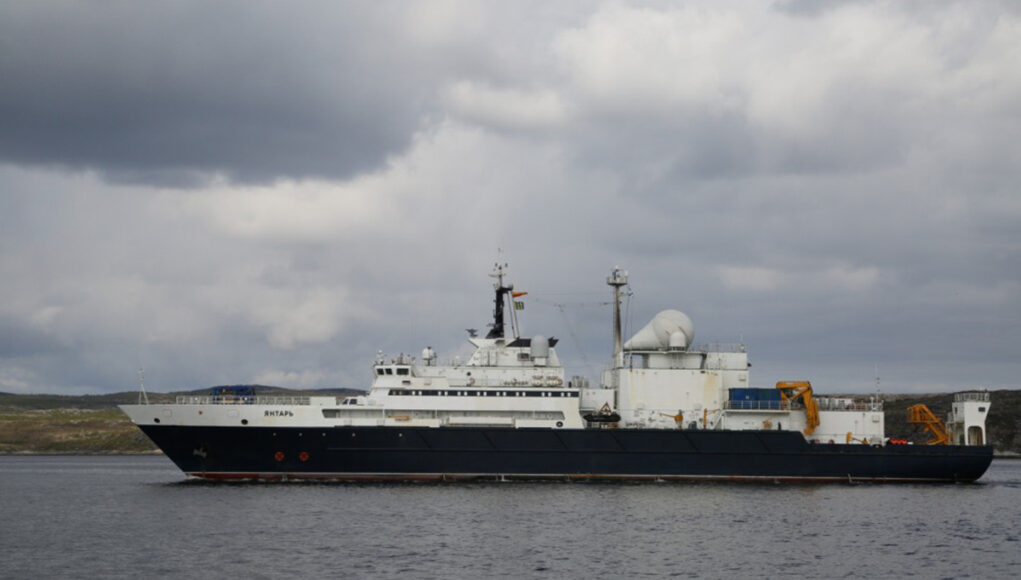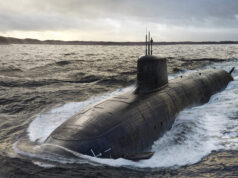A Russian vessel, believed to be gathering intelligence, is under close observation as it passes the UK.
Known as the Yantar, the 107-metre-long ship, often described by Western intelligence as a spy vessel, has been monitored over recent days off the South West coast of the UK and along Norway’s shoreline, areas that hold significance for NATO and the broader security of Europe.
The Royal Navy confirmed it was aware of the Yantar’s presence in the English Channel, with UK surveillance measures being deployed to ensure ongoing observation.
According to an official Royal Navy statement, the UK military “routinely monitors UK territorial waters and the adjacent sea areas to ensure compliance with maritime law, to deter malign activity and to protect our national interests.”
A Poseidon patrol aircraft was recently sent from RAF Lossiemouth to track the Yantar’s movement in an area between Devon and Cornwall.
In Norway, the Yantar’s movements were similarly reported, particularly as it lingered near Andøya Space Port. The vessel’s activity coincided with American-Norwegian military exercises involving personnel from the USS Harry S. Truman, raising questions about the ship’s intentions during sensitive regional drills.
Open-source intelligence trackers noted Yantar’s progression southward along the Norwegian coast.
Built to operate in deep-sea conditions, the Yantar is equipped with autonomous underwater vehicles, allowing it to engage in complex intelligence-gathering operations below the ocean’s surface. Since entering service in 2015, it has often been sighted near critical undersea infrastructure, from telecommunications cables off Cuba’s coast to cable links between Israel and Cyprus, activities which have frequently triggered concerns across NATO-aligned nations.
The ship itself
The Yantar is a Project 22010-class intelligence ship operated by the Russian Navy, equipped with advanced capabilities for deep-sea missions. Acting as a mothership for specialised submersibles, it can deploy the Rus-class and Konsul-class mini-subs, which are capable of reaching depths of up to 6,000 metres (around 20,000 feet). This remarkable range allows Yantar access to and possible interaction with undersea infrastructure, including telecommunications cables stretching across seabeds worldwide. The U.S. Navy has voiced concerns over Yantar’s capability to sever such cables, suggesting it may have uses beyond simple scientific exploration.
Though officially described as an “oceanic research complex” by Alexei Burilichev, head of the Russian Defence Ministry’s deepwater research department, Yantar’s activities have often attracted international scrutiny and raised speculation. The vessel has been observed close to important undersea telecommunications routes and infrastructure, sparking concerns among NATO and other nations about its possible intentions. With a mission profile blending intelligence-gathering and deep-sea research, Yantar serves strategic purposes well beyond civilian applications.
Yantar has made headlines for its presence in key regions. In 2015, it was spotted off the coast of Guantánamo Bay, Cuba, and later in Norwegian waters. In the following years, it appeared near Greenland, Israel, and Cyprus – locations that coincide with sensitive undersea cables or military recovery missions. Notably, in 2017, Yantar was involved in retrieving equipment from crashed Russian aircraft in the Mediterranean and joined international efforts to locate the missing Argentine submarine ARA San Juan.
More recently, Yantar has been reported off the Brazilian coast, in the English Channel, and near Ireland, often closely following submarine cables and sometimes operating without activated identification systems. Its presence in the North Atlantic, especially close to critical transatlantic cables, has led to increased monitoring by NATO countries. In 2023, the Norwegian Coast Guard documented an incident where Yantar shadowed the research vessel RV Kronprins Haakon for over 16 hours, mirroring its movements in what Norwegian officials called harassment, though Yantar adhered to international maritime law.
With a full load displacement of 5,736 tonnes, Yantar is 107.8 metres long and can reach speeds up to 15 knots. Its endurance of 60 days and range of 8,000 nautical miles allow for extended operations in remote areas. The vessel is equipped with two azipods for propulsion, along with a helipad.
At the UK Defence Journal, we aim to deliver accurate and timely news on defence matters. We rely on the support of readers like you to maintain our independence and high-quality journalism. Please consider making a one-off donation to help us continue our work. Click here to donate. Thank you for your support!














Unfortunately the Russians are more than entitled to inspect under sea cables. This is one of the major issues with our greatest ally essentially bragging about submarines and cable tapping missions not to mention the existence of the USS Jimmy Carter.
Almost nothing we can do or say unless we catch them doing something to the cables.
Pity we can’t devise a plausibly deniable accident to the vessel.
There must be some old WW2 sea mines still out there or an unlocated German dropped magnetic mine.
Send in a modern day Buster Crab, only complete this time.
Perhaps we could invite him to dock in Great Yarmouth he could tie up alongside MV Ruby why turn them away
Another smoking accident?
The minute it enters our EEZ it should be boarded for inspection. Looking for contraband, illegal armament etc. let’s lift the lid on the Russian navy’s activity. If it causes a diplomatic incident then that’s Russia’s problem.
We always seem to consider that if undersea comms cables are not currently degraded that no nefarious activity has been carried out by submersibles.
However, I do hope that we are considering, and monitoring for, devices being attached to cables so that they may be triggered and explosively severed if things ever ‘go hot’.
A small fleet of SSKs to monitor these type of ships in these regions might be useful and well overdue?
Perhaps we should treat them the same way the Russians treat our ships? I.e. send fighter jets to buzz them more closely than is really necessary, so they know they’re being watched and are not welcome.
Yes good enough for us good enough for them 😉
But whenever they do that we complain, rightly, that their behaviour is dangerous and not in accordance with diplomatic principles.
We need to retain a measure of moral superiority to demonstrate to the world that we are the “side of good”.
Interesting words, what makes you “side of good”?
Is just UK good or you mean collective West?
I mean that if we use human rights and the rule of law as a stick to beat autocracies with, the West as a whole needs to keep its act together and make sure it follows the rules and acts morally otherwise the whole argument collapses and the countries sitting on the fence will be drawn towards the easy advantages of dictatorship.
There is also the idealism of actually making the world a nicer place to be, but that doesn’t hold up very well in geopolitics.
Thank you for you’re reply. You make more questions for me but I will not take more off your time. Thank you
Seems to me that this kind of situation is what our OPV’s are for, not a minesweeper. An OPV assertively shadowing the Russian ship with it’s own aerial and sub surface drones might help it to move away.